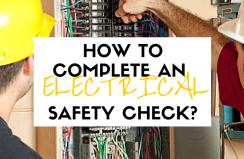Understanding how to complete an electrical safety check is an important part of keeping your home and workplace safe from accidents. We recommend you follow this simple guide to ensure your appliances are in working order and maintained.
1. Determine the hazards
Complete a hazard and risks test to determine the hazards. Make sure you turn off power points and appliances when they are not in use, or if you are not at home. Ensure to leave adequate space between appliances so that they are not inclined to overheating. Be careful and avoid using electrical appliances near sinks, water, bathtubs and showers.
2. Assess risks
View the risks and make changes accordingly. Make sure you know where your switchboard is located and keep access to it clear and label the switches, circuit breakers and fuses so you always know what’s what. This ensures that you can easily respond in an emergency situation and turn off power.
3. Fix problems
If there are any electrical issues or problems be sure to get them fixed. If you have an electrical license or equivalent qualification and are able to work on the appliances then you are able to complete the work yourself, however if not, you must call an qualified electrician to complete the work for you. Replace damaged appliances, frayed cords, cracked or broken plugs. Ensure all appliances have been tested and tagged.
Electrical Shock
If you or someone around you has received an electrical shock, always call 000 straight away to get medical assistance. This is to be treated very seriously. Commence appropriate first aid protocol if necessary.
Electrical Fire
Keep an electrical fire blankets and extinguisher on hand in case of small fires, however always call 000 in the case of an emergency as fires can easily get out of hand.
Through following these steps you can improve your electrical safety and be sure to complete a home safety check every 6-12 months or more often if need be.





